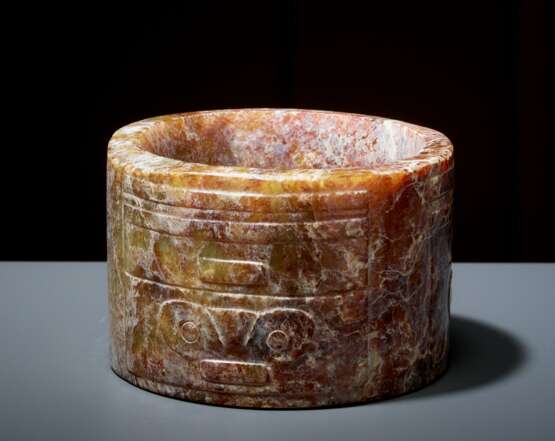ID 935
Lot 42 | SELTENER ARMREIF MIT GÖTTERGESICHTERN SHENMIAN
Estimate value
€ 8 000
Jade
China
Neolithische Kultur von Liangzhu, ca. 3300 - 2200 vor
HÖHE 5,2 CM, DM. 7,9 CM, STÄRKE 5 - 10 MM
神面紋玉琮。中國,良渚文化,約公元前3300-2200 年。高 5.2 厘米, 直徑 7.9厘米,厚0.5 - 1厘米。維也納私人舊藏。
Dieser Armreif sieht zwar den bekannten Cong ähnlich, ist aber keiner. Er hat eine zylindrische Form mit drei großen rechteckigen Relieffeldern außen, die alle auf die gleiche Weise gestaltet und ihrerseits wiederum in drei übereinander liegende Felder geteilt sind. Im untersten größeren Feld befi ndet sich jeweils das für die Liangzhu-Kultur berühmte Maskengesicht mit den großen, rätselhaft-magisch erscheinenden Augen. Sie sind hier mit den schräg gestellten ovalen, leicht vertieften Feldern glatt umrandet, gleichfalls glatt ist das trapezoide Feld zwischen ihnen und der breite Mund. Diese Gesichter zeigen eindeutig ein überirdisches Wesen, die man auch als “Göttergesicht” Shenmian bezeichnen kann. Im Feld darüber ein ungefähr gleich großer Streifen wie der Mund, hier aber die Stirn bedeutend und möglicherweise das “Geistige” symbolisierend. Das verstärken nochmals die zwei ganz breiten Streifen, die den Abschluß bilden. Ist der Reif außen gerade, so ist er innen bemerkenswerter Weise konvex gewölbt. Sehr belebt ist der rotbraune Farbton der Jade aufgrund eines dichten, kleinteiligen weißen Adernwerks sowie auch der Flecken aufgrund der Alterung. Im fokussierten Durchlicht zeigt sich ein deutlich gelbgrüner Ton und das Rötliche dürfte aufgrund von Eisenoxydation entstanden sein. Interessant an dem Stück ist auch, dass das dekorative Feld sehr genau gearbeitet wurde, die Form des Reifes jedoch deutlich Abweichungen zeigt, aufgrund der damals einfachsten Werkzeuge. Die Politur wurde sehr gut ausgeführt, auch innen und hat sich gut erhalten.
Ähnliche Armreifen in verschiedenen Publikationen, etwa in “Chinese Jade. Selected Articles ...” in der Kunstzeitschrift “Orientations”, Hongkong, oder in “Ausgewählte Kulturschätze Chinas” von Shi Shuqing, gleichfalls Hongkong, in Nr. 014.
Diese Jade wird in dem Buch von FILIPPO SALVIATI: “THE MYSTERIOUS STONE: Chinese Jades from the Neolithic to the Han in private collections” publiziert (Erscheinungstermin Frühling 2017).
Notes by Prof. Salviati: This type of bracelet-shaped jade decorated on the outside with two types of masks carved within regular registers, represents a variation of the most common cong form that is so typical of the Liangzhu culture. A very close comparison to the present Lot is offered by a similar bracelet-shaped jade, excavated from tomb 3:43 at Sidun, Changzhou, Jiangsu province, decorated with the same double mask pattern: see Zhejiang institute of cultural relics and archaeology 浙江省文物考古研究所, Liangzhu wenhua yuqi 良渚文化玉器 (Jades of the Liangzhu Culture), Wenwu chubanshe, Beijing 1990, fig.11. In the same volume, see also pls.10, 13 and 14 with bracelet-shaped jades from tombs of the two important cemeteries of Fanshan and Yaoshan located in Yuhang county, Jiangsu. A fourth comparable jade has been discovered in tomb M2:34 of the Huiguanshan site, a few kilometres west of Liangzhu town, in Zhejiang province: it is reproduced in Zhejiang institute of cultural relics and archaeology 浙江省文物考古研究所, Zhejiang kaogu jinghua 浙江考古精华 (The Cream of Zhejiang Archaeology), Wenwu Publishing House, Beijing 1990, p.91. In Western collections, a comparable jade from the Hotung collection, exhibited in the British Museum, is published in J. Rawson, Chinese Jade from the Neolithic to the Qing, London 1995, no.3:1, while a similar bracelet-shaped jade from the collection of Charles Lang Freer (1854-1919) is in the Freer/Sackler Galleries, Washington, D.C., acc. no. F1917.384 and online image aTiefe: http://www.asia.si.edu/collections/edan/object.php?q=fsg_F1917.384
Expertise: Wolfmar Zacken & Filippo Salviati
Aus einer Wiener Sammlung
| Address of auction |
Galerie Zacke Mariahilferstrasse 112 1070 Wien Austria | ||||||||||||||
|---|---|---|---|---|---|---|---|---|---|---|---|---|---|---|---|
| Preview |
| ||||||||||||||
| Phone | +00 4315-320 452 | ||||||||||||||
| Fax | +43-1-5320452-20 | ||||||||||||||
| Buyer Premium | 27.000 | ||||||||||||||
| Conditions of purchase | Conditions of purchase | ||||||||||||||
| Business hours | Business hours
|








